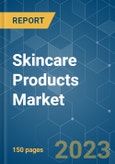The skincare products market is expected to register a CAGR of 4.69% during the next five years.
This product will be delivered within 2 business days.
Key Highlights
- Urban areas have seen an increase in customers' propensity toward various skincare products because of expanding disposable income, intense advertising activities, and the debut of innovative products by manufacturers. For instance, in September 2021, Kao Corporation launched a new Sheet Mask called Smile Performer. The sheet mask claims to add radiance and bounce to the skin, which creates a smiling impression.
- Consumers are using skincare products earlier as they become more aware of skin issues and treatments, which is helping the market grow. An increasing number of women are opting for anti-aging products like L'Oreal Revitalift, Avon Anew Sensitive+, Caudalie premier cru anti-aging cream moisturizer with hyaluronic acid, and many more, which make up a significant sector of the skincare products industry.
- With the growing demand for organic ingredients, consumers across the market are inclined toward organic skin care products, which is expected to drive market growth during the study period. Furthermore, the rising awareness about the harmful effects of chemicals and synthetic products is another factor augmenting the development of the market. Most consumers tend to buy products with natural or organic labeling, which drives market growth.
- People face significant skin rashes and sensitivity in many regions due to environmental conditions like UV rays, deserts, and pollution. This is why they prefer products with hydrating properties like vitamin C serums, hyaluronic acid creams, and face masks, which also drive the market. For instance, in June 2022, Biologi, an Australian clean cosmeceutical business, unveiled an anti-pollution serum with a wild-harvested extract containing vitamin C, niacinamide, and salicylic acid.
- The Bg defence anti-pollution serum is the newest addition to Biologi's distinctive serum line, and it features strawberry gum leaf extract as its main ingredient. The serum is designed to shield and protect skin against environmental assaults like blue light and pollution on a daily basis.
Skincare Products Market Trends
Growing Demand for Anti-Aging and Anti-Pollution Ranges
- Anti-aging products such as anti-wrinkle creams, face creams, serums, and eye creams are in high demand. Furthermore, problems such as pollution and challenging water conditions are blasting the need for such products. A growing number of people are becoming aware of the effects of pollution on the skin. As a result, customers are more likely to spend money on skincare treatments while they are younger. They devote a large amount of time and money to anti-aging products.
- The demand for anti-aging creams for younger skin is increasing. The ingredients like vitamins C, E, collagen, and many more are used in anti-aging creams. The market players are adopting innovative strategies such as product innovations, mergers, and acquisitions to strengthen their position in the anti-aging segment in the global market.
- For instance, in September 2022, L'Oréal signed an agreement to acquire SkinBetter Science, a physician-dispensed American skincare brand. Skinbetter Science is known for formulating innovative products with active ingredients for anti-aging, moisturizing, cleansing, exfoliating, skin peeling, and sun protection.
Asia-Pacific Registers the Fastest Growth Rate
- In highly growing economies such as China, South Korea, India, and Indonesia, rising population, rapid urbanization, and increased per capita spending on personal care products all contribute to the region's skincare market's growth. Furthermore, the growing availability of affordable skincare products contributes to the growth of the skincare market. As a result, key players focus heavily on product innovation and mergers and acquisitions as their primary strategies for consolidating the market under consideration.
- For instance, in January 2022, Galderma, the world's largest dermatology company, completed the acquisition of Alastin Skincare Inc., a specialty aesthetics company dedicated to developing innovative and clinically-tested physician-dispensed skincare products.
- As the growing number of beauty salons is now omnipresent across most Indian towns and cities, with more extensive shopping malls in metropolitan centers stocking beauty and skincare products of major mainstream personal care brands, India provides a massive market. The demand for organic skin care products is also growing in Asia because of skin-related problems due to chemicals and environmental issues.
Skincare Products Market Competitor Analysis
The skincare products market is highly competitive, with the top global and regional players competing fiercely to garner market share. Some major key players in the skincare products market include Procter & Gamble Company, Beiersdorf AG, the Estee Lauder Companies Inc., Unilever, and L'Oreal. The key players are embarking on mergers and acquisitions as a strategy to strengthen their market dominance. The major players are constantly trying to expand their production facilities and increase their market presence locally via this strategy. Similarly, companies are innovating their products and advertising advanced and niche categories, which can eliminate recurring problems consumers face due to pollution, aging, and lack of time for care.Additional benefits of purchasing the report:
- The market estimate (ME) sheet in Excel format
- 3 months of analyst support
This product will be delivered within 2 business days.
Table of Contents
1 INTRODUCTION
4 MARKET DYNAMICS
5 MARKET SEGMENTATION
6 COMPETITIVE LANDSCAPE
Companies Mentioned (Partial List)
A selection of companies mentioned in this report includes, but is not limited to:
- L'Oréal S.A.
- Unilever PLC
- The Estée Lauder Companies Inc.
- Procter & Gamble Company
- maxingvest AG (Beiersdorf AG)
- Amorepacific Corporation
- Shiseido Company, Limited
- Johnson & Johnson Services Inc.
- Kao Corporation
- Colgate-Palmolive Company
Methodology

LOADING...










